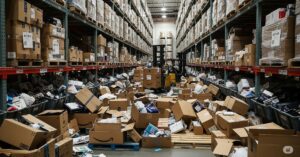
Driven by escalating geopolitical risks and the dramatic increases in tariffs on foreign imports, US Supply Chain Reshoring is accelerating as companies seek to mitigate rising costs for apparel, electronics, and automotive parts by prioritizing domestic production and shorter lead times.
After decades of watching production lines move overseas, the American manufacturing sector is experiencing a historic reversal. Driven by the strategic need for resilience over mere cost savings, companies are abandoning fragile, long-distance supply chains to establish new industrial bases in the US Heartland.
This return represents billions in new capital and a revitalization of American industry. How big is this change?
The scale is enormous: last year alone, 244,000 reshoring and FDI-related manufacturing jobs were announced, a stunning figure that cements the US Supply Chain Reshoring movement as the defining economic story of the decade.
Reshoring as a Strategic Move, Not a Sentimental One
Julia Wendling, Visual Capitalist"In 2023, U.S. reshoring announcements totaled $933 billion. By the end of 2024, that figure had surged to $1.7 trillion."
Armando Roggio reported on Practical Ecommerce that Reshoring Is Supply Chain Flexibility. He explained that moving production closer to home, beyond supplier choice and tariffs, benefits both businesses and the broader economy.
Reshoring is not about nostalgia or nationalism. It is a pragmatic step for brands realizing that producing goods domestically can improve speed, control, and resilience after decades of chasing the lowest overseas bids.
Even major retailers are taking the lead. Walmart, for instance, continues to expand its US-based manufacturing footprint, inviting more than 500 entrepreneurs to its annual Open Call to pitch products made, grown, or assembled in the country.
The initiative supports Walmart’s $350 billion, 10-year commitment to domestic sourcing and represents a significant opportunity for small and mid-sized producers. New ventures, such as its beef-processing facility in Kansas and a partnership with USAntibiotics, are expected to create hundreds of American jobs while reinforcing local supply networks.
Walmart’s approach combines global efficiency with local stability. By reshoring when it adds flexibility and continuing to source globally for select goods, the company demonstrates how balance, not retreat, defines modern supply chain strategy.
Tariffs remain a central factor in this equation. While they raise costs for retailers and consumers, companies are adapting through diversification, bulk purchasing, and factory renegotiations rather than simply increasing prices.
Industry experts note that tariffs have pushed many ecommerce brands, including Amazon sellers, to move production from China to countries like Vietnam or back to the United States. Those that stay abroad often adjust through new pricing models and long-term contracts to protect margins.
Reshoring now signals renewed industrial investment in America. Companies such as Nucor, Cleveland-Cliffs, Whirlpool, and Vaughan-Bassett are expanding operations, proving that domestic manufacturing can be both practical and profitable.
Key advantages of reshoring include:
- Shorter lead times – Proximity reduces transit delays and improves cash flow.
- Better quality control – Local oversight allows quicker problem-solving and communication.
- Stronger consumer appeal – “Made in the USA.” continues to build trust and justify premium pricing.
Reshoring, at its core, is about restoring balance in global commerce. Combining domestic production for critical goods with international sourcing for specialized categories helps brands maintain both stability and scalability.
For ecommerce businesses, including those guided by an Amazon agency, adopting this model can turn reshoring into a competitive advantage rooted in quality, reliability, and customer confidence.
Winners and Movers Emerge From the US Supply Chain Reshoring Wave
In a report on Motley Fool, Jeremy Bowman wrote Which US Companies Are Poised to Profit From Reshoring Supply Chains, highlighting how new tariffs have accelerated supply chain realignments across industries. The reshoring movement, once a slow trend, has gained momentum as companies restructure operations to offset higher import taxes and maintain control over production.
The early phase of tariff implementation prompted immediate reactions. Some companies scrambled to mitigate rising costs, while others seized the opportunity to invest in domestic capacity and logistics infrastructure.
Prologis stands among the leading beneficiaries of this shift. As the world’s largest logistics real estate owner, it supplies warehouse space to major operators like Amazon and FedEx, supporting manufacturers bringing production back to US soil.
Demand for storage and distribution facilities continues to climb, with leasing activity reaching record levels. The company’s growth in both the US and Mexico underscores the twin trends of reshoring and nearshoring, which strengthen regional supply resilience.
Manhattan Associates is another company capitalizing on reshoring momentum. Its logistics software helps brands streamline warehouse management, distribution, and order fulfillment as production relocates closer to American customers.
The company has seen measurable gains in performance obligations and backlog growth, indicating rising demand from manufacturers optimizing domestic operations. Its technology-driven approach supports efficiency gains essential for competing under tighter trade rules and shorter delivery expectations.
Intel represents reshoring from a national security and technology standpoint. Backed by $8 billion in CHIPS Act funding and an additional $8.9 billion federal investment, the company anchors efforts to rebuild US semiconductor production capacity.
Government incentives and private investments, including multibillion-dollar stakes from Nvidia and potential interest from Apple, signal confidence in restoring American manufacturing leadership in critical sectors. Despite near-term revenue challenges, Intel remains strategically vital to the reshoring agenda.
The broader trend shows that US Supply Chain Reshoring is not just about manufacturing relocation – it’s about ecosystem rebuilding. Real estate, logistics technology, and semiconductor manufacturing are converging to form the backbone of a more self-sufficient, resilient US industrial base.
High-Tech Manufacturing Dominates the Reshoring Landscape
The surge in US supply chain reshoring is heavily concentrated in high-technology sectors targeted by federal industrial policies. According to a report on FCNews, about 88% of all announced jobs in 2024 were in high or medium-high tech industries critical to national and economic security.
Semiconductors Drive Unprecedented Capital Investment
The semiconductor and computer/electronics sector led the reshoring wave, powered by incentives under the CHIPS Act. This segment generated 35% of all announced jobs in 2024 and attracted roughly $102.6 billion in capital investment, representing about two-thirds of all foreign capital entering the U.S. between late 2024 and early 2025.
Clean Energy Manufacturing Accelerates
Electrical equipment production, especially EV batteries and solar components, accounted for 31% of 2024’s announced jobs. Bolstered by the Inflation Reduction Act (IRA), automakers and energy firms are building a domestic supply chain to support long-term clean energy independence.
Automotive Sector Rebounds Amid Trade Pressure
After years of stagnation, automotive and transportation equipment manufacturing is seeing renewed growth. Job announcements are projected to jump 139% from 2024 as companies reshore entire assembly operations in anticipation of new auto tariffs in 2025.
Strategic Reshoring in Critical Industries
Medical devices, aerospace, and pharmaceuticals are also contributing to the reshoring trend through smaller-scale but strategically vital projects. These industries prioritize quality assurance, supply chain resilience, and intellectual property protection over direct subsidies.
Ecommerce Sellers Face New Realities Amid US Supply Chain Reshoring
The US supply chain reshoring wave is reshaping how e-commerce sellers operate, presenting both strategic challenges and new opportunities. For many Amazon sellers, especially private-label brands, the traditional model of sourcing from low-cost overseas manufacturers is being tested by shifting trade policies and rising global uncertainty.
Supply Chain Resilience and Sourcing Strategy
The primary motivation behind reshoring is building more resilient supply chains less exposed to global shocks. Geopolitical tensions, port congestion, and tariff swings have underscored the risks of long-distance manufacturing dependency.
- Tariffs and Trade Policy – Tariffs can raise Costs of Goods Sold (COGS) by 10–25%, creating uncertainty that complicates financial planning and forces sellers to diversify sourcing.
- Nearshoring – Moving production to nearby countries like Mexico allows sellers to benefit from USMCA trade advantages, reduced shipping costs, and faster delivery times.
- Supplier Diversification – Sellers are spreading production across regions to minimize risk, with tools like Amazon’s Manufacturing Central helping connect them to vetted factories outside China.
The New Cost Equation Involves Total Cost of Ownership
Manufacturing decisions are shifting away from a simple labor-cost focus toward a Total Cost of Ownership (TCO) framework. This model includes not just production costs, but also logistics, tariffs, quality control, and the financial risks of long supply chains.
- Beyond Price – Factoring in shipping, inventory, and disruption risks often reveals that nearshore or domestic production is more cost-efficient than it appears.
- Impact on Cash Flow – Shorter supply chains mean faster restocking and less capital tied up in inventory, improving liquidity and financial flexibility for sellers.
Customer Expectations and Brand Narrative
Consumer preferences are also aligning with reshoring trends, as faster delivery and product quality become key differentiators.
- Speed and Fulfillment – Domestic or nearshore production allows sellers to meet expectations for rapid delivery and reliable inventory availability.
- Quality Control – Local manufacturing enables tighter oversight, reducing defects and returns while enhancing brand trust.
- “Made in the USA” Appeal – Products labeled as domestically made can strengthen brand perception, though price and convenience still drive most Amazon purchases.
The Competitive Landscape
Reshoring is creating a more complex and competitive environment on Amazon. Sellers must balance rising costs with consumer price sensitivity while maintaining product availability.
- Pricing Pressure – Tariff-related cost increases cannot always be passed to buyers without losing sales, forcing operational efficiency and creative pricing strategies.
- Agility as an Advantage – Sellers who adapt quickly through reshoring, nearshoring, or diversification will stand out. Their ability to deliver consistently despite global disruptions gives them an edge in a crowded marketplace.
E-commerce sellers should treat reshoring as a strategic evolution, not a disruption. It offers a chance to strengthen control, reliability, and customer trust – core advantages in an increasingly unpredictable global trade environment.
Kearney Reshoring Index“The next phase of reshoring will hinge on tough choices - what to make, where to invest, and how to stay competitive as supply chains adapt to a faster, fragmented world.”






